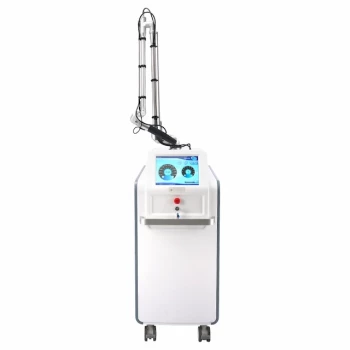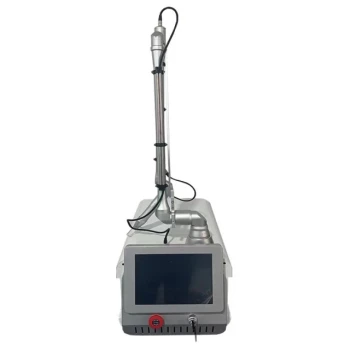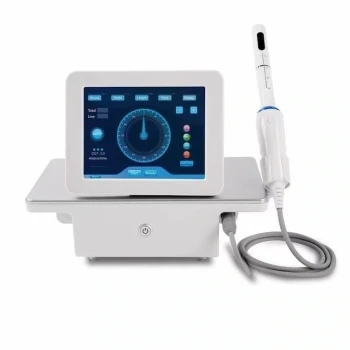At its core, a medical laser works by generating an intense, highly focused beam of single-wavelength light. This beam is precisely controlled and aimed at a specific biological target within the body. When the light energy hits this target—such as water, pigment, or blood—it is absorbed and converted into heat or mechanical energy, allowing clinicians to cut, vaporize, coagulate, or destroy tissue with remarkable precision.
The true power of a medical laser lies not in its intensity, but in its selectivity. By tuning the laser's wavelength to match a specific "chromophore" (a light-absorbing molecule) in tissue, it can destroy a target structure while leaving adjacent, healthy tissue virtually untouched.
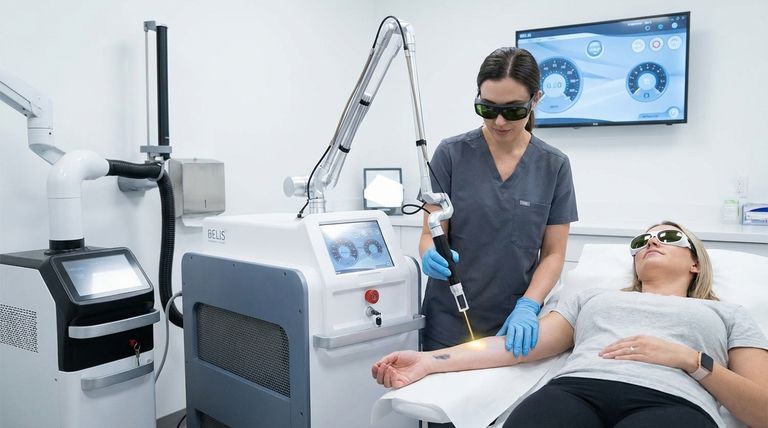
The Core Principle: Selective Photothermolysis
The foundational concept that makes medical lasers so effective is known as selective photothermolysis. This term breaks down into its component parts: selective (targeting a specific structure), photo (using light), thermo (to create heat), and lysis (to cause destruction).
Understanding Chromophores: The Laser's Target
For a laser to have any effect, its light energy must be absorbed. The molecules in the body that absorb specific wavelengths of light are called chromophores.
The three most important chromophores in medical laser applications are water, hemoglobin, and melanin. A laser's medical utility is determined by which chromophore it targets most effectively.
How Wavelength Determines the Effect
Different lasers produce different wavelengths of light, which are chosen to match the absorption peak of a desired chromophore.
- CO₂ lasers (10,600 nm) are intensely absorbed by water. Since all soft tissue is mostly water, these lasers are excellent tools for general tissue cutting and vaporization (ablation).
- Pulsed Dye Lasers (PDL) (585 or 595 nm) are strongly absorbed by hemoglobin, the molecule in red blood cells. This makes them ideal for treating vascular lesions like port-wine stains or spider veins, as they can heat and destroy blood vessels without harming the overlying skin.
- Alexandrite lasers (755 nm) are well-absorbed by melanin, the pigment in skin and hair. This allows for the selective destruction of hair follicles for laser hair removal or the breakdown of excess pigment in age spots.
It's Not Just About Heat
While most medical lasers work by converting light to heat, other interactions are also possible.
High-powered, rapidly pulsed lasers can create a photomechanical effect, where a microscopic shockwave is generated. This is the principle used to break up kidney stones (lithotripsy) or fragment tattoo ink particles.
From Physics to a Medical Tool
The term LASER stands for Light Amplification by Stimulated Emission of Radiation. This process happens within the device itself to create its unique, medically useful beam.
The Gain Medium
This is the core material—a solid crystal (like Nd:YAG), a gas (like CO₂), or a semiconductor diode—that determines the laser's fundamental wavelength.
The Excitation Source
An external energy source, like a powerful flashlamp or an electrical current, is used to "pump" energy into the atoms of the gain medium, pushing them into an excited, unstable state.
The Optical Resonator
As the excited atoms return to their stable state, they release photons (light particles) of a specific wavelength. These photons are bounced back and forth between two highly reflective mirrors, stimulating other excited atoms to release identical photons. This process amplifies the light, creating a beam that is collimated (parallel), monochromatic (single wavelength), and coherent (in phase).
Understanding the Trade-offs and Safety Risks
A laser's precision is also its primary hazard. The same properties that allow it to destroy a target cell can cause significant harm if misused.
The Danger of Collateral Damage
If the laser's power is too high or the pulse duration is too long, the generated heat can spread beyond the target chromophore. This thermal diffusion can burn or damage healthy surrounding tissue, leading to scarring and other complications.
Eye Safety is Non-Negotiable
The lens of the human eye can focus a laser beam onto the retina with extreme intensity, causing permanent blindness in an instant. All personnel in the room must wear specific safety goggles designed to block the exact wavelength of the laser being used.
The Hazard of the Laser Plume
When a laser vaporizes tissue, it creates a "plume" of smoke. This plume can contain viable bacteria, viruses, and potentially toxic chemical byproducts. Effective smoke evacuation and filtration systems are a critical safety requirement during ablative procedures.
Making the Right Choice for the Goal
The selection of a medical laser is dictated entirely by the clinical objective and the target tissue.
- If your primary focus is precise tissue cutting or broad vaporization: You need a laser highly absorbed by water, such as a CO₂ or Er:YAG laser.
- If your primary focus is treating blood vessels or vascular lesions: You need a laser that targets hemoglobin, like a Pulsed Dye Laser (PDL) or a specific setting on an Nd:YAG laser.
- If your primary focus is removing hair or pigmented spots: You need a laser targeting melanin, such as an Alexandrite, Diode, or Nd:YAG laser.
- If your primary focus is breaking up hard structures like tattoos or kidney stones: You need a Q-switched laser that produces powerful photomechanical effects.
By matching the properties of the light to the properties of the tissue, the laser is transformed from a simple beam of energy into a uniquely precise surgical instrument.
Summary Table:
| Key Component | Role in Medical Laser Function |
|---|---|
| Wavelength | Determines which chromophore (e.g., water, hemoglobin) the laser targets. |
| Chromophore | The specific molecule in tissue (e.g., melanin) that absorbs the laser's light energy. |
| Selective Photothermolysis | The core principle: using light to create heat and destroy a target while sparing surrounding tissue. |
| Gain Medium | The material (e.g., CO₂ gas, Alexandrite crystal) that generates the laser's specific wavelength. |
Ready to integrate this precision into your practice?
BELIS specializes in providing professional medical aesthetic equipment to clinics and premium beauty salons. Our experts can help you select the ideal laser system—whether for hair removal, vascular treatments, or skin resurfacing—to enhance your service offerings, improve patient outcomes, and grow your business.
Contact our specialists today for a personalized consultation and discover the BELIS difference.
Visual Guide
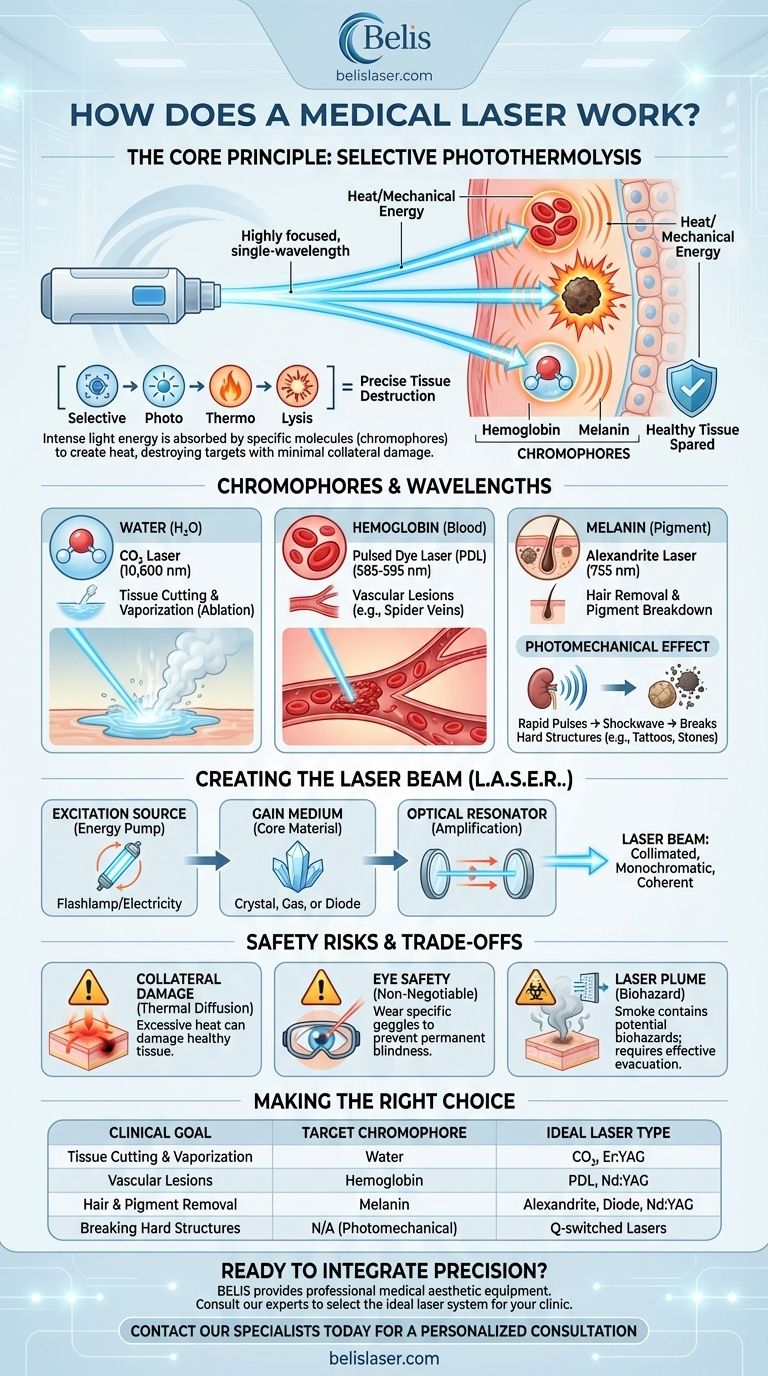
Related Products
- Pico Laser Tattoo Removal Machine Picosure Picosecond Laser Machine
- Pico Picosecond Laser Machine for Tattoo Removal Picosure Pico Laser
- Fractional CO2 Laser Machine for Skin Treatment
- Fractional CO2 Laser Machine for Skin Treatment
- Diode Laser SHR Trilaser Hair Removal Machine for Clinic Use
People Also Ask
- Who is suitable for Pico laser? A Guide for Tattoo Removal, Pigmentation & Acne Scars
- What is the disadvantage of Pico laser treatment? Understand the Risks and Costs Before You Decide
- What is the case of most adverse reactions after laser? Prevent Post-Inflammatory Hyperpigmentation
- How does a laser tattoo removal machine work? Shattering Ink with Precision Light
- What does Pico do for skin? Unlock Non-Invasive Skin Rejuvenation
